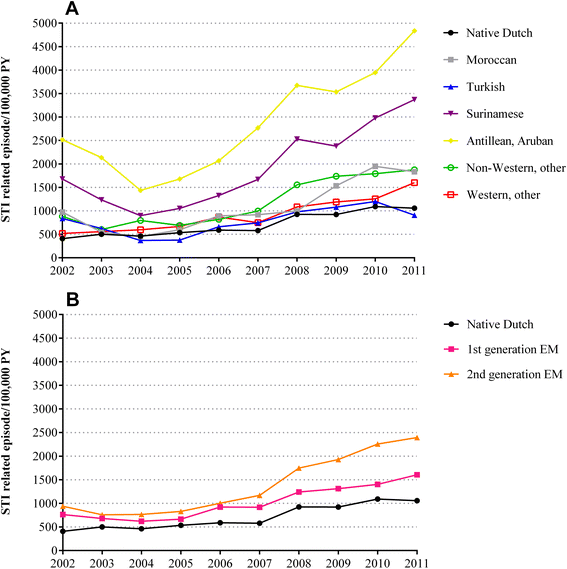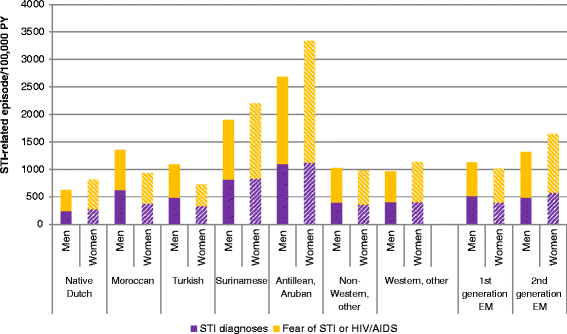Comparison of STI-related consultations among ethnic groups in the Netherlands: an epidemiologic study using electronic records from general practices
- PMID: 26084618
- PMCID: PMC4470336
- DOI: 10.1186/s12875-015-0281-2
Comparison of STI-related consultations among ethnic groups in the Netherlands: an epidemiologic study using electronic records from general practices
Abstract
Background: Currently, surveillance of sexually transmitted infections (STIs) among ethnic minorities (EM) in the Netherlands is mainly performed using data from STI centers, while the general practitioner (GP) is the most important STI care provider. We determined the frequency of STI-related episodes at the general practice among EM, and compared this with the native Dutch population.
Methods: Electronic medical records from 15-to 60-year-old patients registered in a general practice network from 2002 to 2011 were linked to the population registry, to obtain (parental) country of birth. Using diagnoses and prescription codes, we investigated the number of STI-related episodes per 100,000 patient years by ethnicity. Logistic regression analyses (crude and adjusted for gender, age, and degree of urbanization) were performed for 2011 to investigate differences between EM and native Dutch.
Results: The reporting rate of STI-related episodes increased from 2004 to 2011 among all ethnic groups, and was higher among EM than among native Dutch, except for Turkish EM. After adjustment for gender, age, and degree of urbanization, the reporting rate in 2011 was higher among Surinamese [Odds Ratio (OR) 1.99, 95 % confidence interval (CI) 1.70-2.33], Antillean/Aruban (OR 2.48, 95 % CI 2.04-3.01), and Western EM (OR 1.24, 95 % CI 1.11-1.39) compared with native Dutch, whereas it was lower among Turkish EM (OR 0.48, 95 % CI 0.37-0.61). Women consulted the GP relatively more frequently regarding STIs than men, except for Turkish and Moroccan women.
Conclusions: Most EM consult their GP more often for STI care than native Dutch. However, it remains unclear whether this covers the need of EM groups at higher STI risk. As a first point of contact for care, GPs can play an important role in reaching EM for (proactive) STI/HIV testing.
Figures



References
-
- van Aar F, Koedijk FDH, Van den Broek IVF, Op de Coul EL, Soetens LC, Woestenberg PJ, et al. Sexually Transmitted Infections Including HIV, in the Netherlands in 2013. Bilthoven: National Institute for Public Health and the Environment; 2014.
-
- van den Broek IV, Verheij RA, van Dijk CE, Koedijk FD, van der Sande MA, van Bergen JE. Trends in sexually transmitted infections in the Netherlands, combining surveillance data from general practices and sexually transmitted infection centers. BMC Fam Pract. 2010;11:39. doi: 10.1186/1471-2296-11-39. - DOI - PMC - PubMed
-
- Van Veen M, Van der Sande M, David S, Koedijk F. Aanvullende regeling Seksuele Gezondheidszorg (ASG) - Betere aansluiting preventie en behandeling. [Additional arrangement sexual healthcare (ASG) – Better connection between prevention and cure] Seksoa. 2012;3(1):8–9.
Publication types
MeSH terms
LinkOut - more resources
Full Text Sources
Other Literature Sources
Medical
Research Materials

